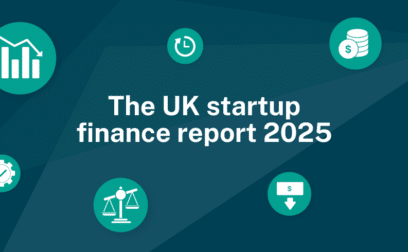TABLE OF CONTENTS

Page written by Chris Godfrey. Last reviewed on October 1, 2024. Next review due April 6, 2026.

More than half of UK SMEs (source: Experian) say poor cashflow is the biggest issue for their business. Slow payment for goods or services delivered is a common problem. As more of the world’s trade is dominated by huge corporations, and suppliers must accept their extended payment terms, it’s unlikely this situation will improve. Fortunately, there is a solution for those who wish to take it – step forward supply chain finance – the short-term, unsecured lending option that delivers a win/win for all: Suppliers get paid faster and save on fees. Buyers protect working capital and keep their trading partners happy. Supply chain financing – where everyone’s a cashflow king.
Supply chain finance provides unsecured cash advances to the supplier(s) in a supply chain. It gets them paid early. This type of lending is also called ‘supplier finance’, but unlike traditional factoring or invoice-financing it’s cashflow positive for both buyer and seller – allowing suppliers to get paid sooner and buyers to extend the usual grace period before they must pay for the supplies they purchase. Because the finance is based on the credit score of the buyer, who are usually larger companies than their suppliers and who typically enjoy a stronger financial base, the fees that are paid by the supplier for receiving early payment are often less than they would pay with standard factoring or other forms of business finance. The buyer pays no fees in the transaction.
Every transaction in supply chain finance is a co-operation between supplier, buyer, and lender. All parties benefit from the deal and the strength of the buyer’s credit is the transaction anchor. Because larger buyers are highly likely to honour invoices from their smaller suppliers, lenders tend to consider these bills a ‘safe bet’ and they will lend against the invoice value. This allows suppliers to receive 100% of the due sum as an advance from the lender, (minus a small fee), once the buyer has approved the invoice for payment.
The process works like this:
Is supply chain financing the best option for your business? Find out more. Contact us today.

A word from Andrea
"More than half of UK SMEs say poor cashflow is the biggest issue for their business. With supply chain finance, you are able to use unsecured cash advances to pay suppliers in a supply chain. Unlike traditional factoring or invoice-financing, it’s cashflow positive for both buyer and seller, as buyers protect their working capital, all whilst keeping their trading partners happy."

Pros
Supply chain finance is beneficial for both buyer and supplier.

Cons
Pros and cons come with all finance arrangements. Key disadvantages of supply chain finance are:
AAA Engineering is an SME who provides finished components to Global Motors, a large multi-conglomerate. Global Motors purchases £1m of components from AAA. Normal payment terms are 60 days from the date of delivery. However, AAA must pay for raw materials and component parts in 30 days, and they represent 65% of the total deal value (£650,000). This means AAA will need to pay out £650k before they get paid by Global – a potential cashflow issue.
Global offers AAA the option of supply chain financing. A lender will make AAA an immediate cash advance of £1m, minus their fee, with Global Motors paying the lender back in 90 days. AAA accepts the deal.
This arrangement is a win/win for everyone, as it allows AAA to get paid before they must pay for the raw materials worth £650k, and thus avoid a cashflow crunch. It also allows Global the chance to extend their payment cycle from 60 to 90 days, reducing impact on their working capital.
Because supply chain finance is effectively backed by the credit rating of the buyer, who is typically larger and with greater financial strength than their suppliers, the fees that lenders charge suppliers for financing are often less than for factoring and many other types of business finance. Note that deal terms may vary with each transaction, but in all cases, the following rules apply:
A blockchain is an expanding chain of digital records called blocks. They are linked together using powerful cryptography, which makes them very secure. Because every block in the chain has a unique timestamp (denoting when it was created) and an action data, (such as the record of a purchase), the blockchain can provide a high degree of transparency or ‘truth’ in a total transaction.
The most well-known use of blockchain technology is with cryptocurrencies such as Bitcoin, but the technology has other uses, and although it has yet to become widely used in common commercial trade, it may be well suited to supply chain finance:
Read more: our in-depth look at blockchain technology in supply chain finance
Trade finance and supply chain finance are both designed to finance international and domestic supply chains, but they are not the same thing.
No. With traditional factoring, the supplier seeks to borrow against the value of its invoices to improve cashflow. The supplier sells their invoices to a lender (the ‘factor’) who takes control of the supplier’s sales book. This form of lending changes nothing for the buyer and because it relies more on the financial strength of the supplier, it can be expensive for some firms. Additionally, factoring will usually only provide up to 80% of invoice value as an advance. With supply chain financing, the buyer seeks borrowing to extend payment terms for the supplies it purchases. The supplier does not sell their invoices to the lender. The buyer pays nothing for this form of lending, but they offer their financial strength as security for the loans. This has the double benefit of improving cashflow for the buyer and the supplier, who receives payment much sooner and at a lower cost than factoring.
Dynamic discounting and supply chain finance are funding options that allow a buyer to support their top suppliers by making early payment of their invoices. However, they are not the same thing.
Unsecured supply chain finance is a financier’s term used to describe the lack of tangible security in a supply chain financing transaction. Unlike invoice-financing, factoring, or bank loans, supply chain financing does not place a lien, (or claim ownership) on any assets in the transaction – such as invoices, a company’s sales ledger, inventory, or hard assets such as property. Supply chain financing relies solely on the confidence that the buyer will pay a supplier’s invoice. Because there is no other collateral involved it is called ‘unsecured’ and it is always short-term lending.
No matter if you’re a buyer or a seller, cash is king in business. Get paid sooner, pay bills later, take firm control of your working capital. Register your business with Swoop to discover more about supply chain financing and how to make your cash work harder for your company.
Written by
Chris is a freelance copywriter and content creator. He has been active in the marketing, advertising, and publishing industries for more than twenty-five years. Writing for Barclays Bank, Metro Bank, Wells Fargo, ABN Amro, Quidco, Legal and General, Inshur Zego, AIG, Met Life, State Farm, Direct Line, insurers and pension funds, his words have appeared online and in print to inform, entertain and explain the complex world of consumer and business finance and insurance.
Swoop promise
At Swoop we want to make it easy for SMEs to understand the sometimes overwhelming world of business finance and insurance. Our goal is simple – to distill complex topics, unravel jargon, offer transparent and impartial information, and empower businesses to make smart financial decisions with confidence.
Find out more about Swoop’s editorial principles by reading our editorial policy.
Related pages
Get your free Supply chain finance quote today
Join the 110,000+ businesses just like yours getting the Swoop newsletter.
Free. No spam. Opt out whenever you like.



























We work with world class partners to help us support businesses with finance
Kingfisher Way, Silverlink Business Park, Newcastle upon Tyne, NE28 9NX, UK
View in Google MapsAberystwyth Innovation and Enterprise Campus
Gogerddan Campus
Aberystwyth University
Ceredigion
SY23 3EE
Dogpatch Labs, The CHQ Building, Custom House Quay, Dublin, Ireland
View in Google MapsSuite 801, Level 8, 84 Pitt Street, Sydney, NSW 2000, Australia
View in Google Maps43 W 23rd St, New York, NY 10010, United States
View in Google Maps21 Dreyer Street, Cape Town, South Africa, 7708
View in Google Maps
Disclaimer: Swoop Finance helps UK firms access business finance, working directly with businesses and their trusted advisors. We are a credit broker and do not provide loans or other finance products ourselves. We can introduce you to a panel of lenders, equity funds and grant agencies. Whichever lender you choose we may receive commission from them (either a fixed fee of fixed % of the amount you receive) and different lenders pay different rates. For certain lenders, we do have influence over the interest rate, and this can impact the amount you pay under the agreement. All finance and quotes are subject to status and income. Applicants must be aged 18 and over and terms and conditions apply. Guarantees and Indemnities may be required. Swoop Finance can introduce applicants to a number of providers based on the applicants’ circumstances and creditworthiness. Swoop Finance Limited is registered with the Financial Conduct Authority as an Account Information Services Provider (reference number 833145). Swoop Finance Limited is authorised as a credit broker under FCA registration number 936513. If you feel you have a complaint, please read our complaints section highlighted above and also contained within our terms and conditions. Swoop Finance Ltd is registered with Companies House (company number 11163382, registered address The Stable Yard, Vicarage Road, Stony Stratford, Milton Keynes MK11 1BN). VAT number: 300080279
Clever finance tips and the latest news
Delivered to your inbox monthly
Join the 110,000+ businesses just like yours getting the Swoop newsletter. Free. No spam. Opt out whenever you like.
Thanks for requesting a call back
a member of the team will be in touch.




